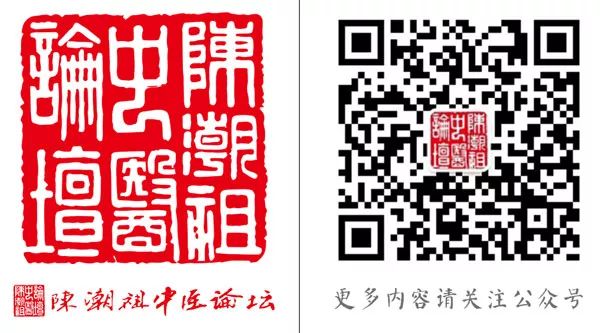
The Six Excessive Evils, namely Wind, Cold, Heat, Dampness, Dryness, and Fire (Heat), are collectively referred to as external pathogenic factors. The term “excessive” implies both excess and infiltration. The occurrence of diseases caused by the Six Excessive Evils mainly happens under two conditions. First, when the climate during an outbreak deviates significantly from the usual climate, either excessively or insufficiently, or when there are abnormal climatic changes, the Six Qi transform into Six Excessive Evils that invade the human body and cause disease. Second, when the body’s righteous Qi is weak and its ability to adapt is low, climatic changes can act as pathogenic conditions leading to disease. The onset of the Six Excessive Evils is characterized by external invasion, seasonality, regionality, and their interrelated nature. In addition to climatic factors, the pathogenic effects of the Six Excessive Evils also include biological (bacteria, viruses, etc.), physical, and chemical factors that cause pathological reactions in the body.
1. Pulse Manifestations of Wind Evil
When the Wind Qi is excessive and harms the body, it is classified as Wind Evil. Wind is a Yang evil characterized by its lightness and upward movement, possessing the properties of upward, outward, and instability; Wind Evil is known for its mobility and unpredictability, often accompanying other evils to cause disease.
(1) Elements of Pulse Manifestation for Wind Evil
1. Local Pulse Manifestation Elements
Protrusion: Wind Evil easily attacks Yang positions and can be received from above, hence the pulse at the cun position may show grain-like or soft protrusions.
2. Overall Pulse Manifestation Elements
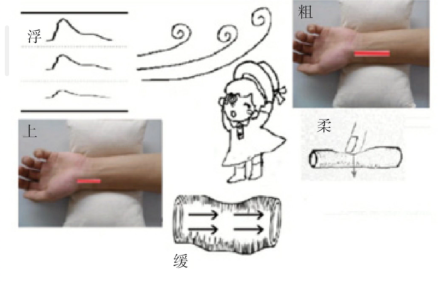
Upward, Floating: Wind Evil stimulates the movement of Qi and blood towards the upper and outer parts, hence the pulse is upward and floating.
Rough, Soft: The nature of Wind is to disperse the muscles and skin, resulting in a rough pulse and decreased tension in the radial artery walls.
Slow: Wind Evil disperses the muscles and skin, leading to a rough pulse and decreased tension in the radial artery walls.
(2) Systematic Differentiation of Pulse Manifestation
In clinical pulse diagnosis, the pulse characteristics of floating, soft, and slow can indicate the diagnosis of Wind Evil. Based on the accompanying pulse manifestations, different syndromes can be differentiated. If the cun position also shows protruding pulse elements, it indicates Wind Evil disturbing the upper body; if the overall pulse shows rough, soft, and slow elements, it indicates Wind Evil attacking the exterior.
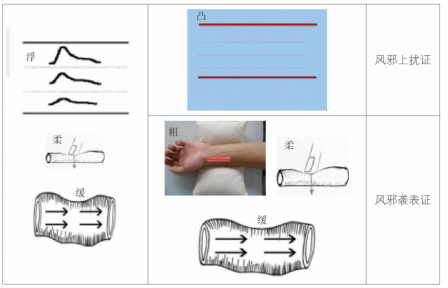
2. Pulse Manifestations of Cold Evil
Excessive cold that harms the body is classified as Cold Evil. Cold is a Yin evil characterized by congealing, obstructing, and retracting properties, which can easily cause Qi to contract, and blood and fluids to congeal, leading to contraction and spasms of the skin, meridians, and tendons. Cold Evil is commonly seen in winter but can also occur in other seasons. When Cold invades the skin and obstructs the Yang Qi, it is termed “Shang Han”; when Cold directly penetrates the interior and harms the Yang Qi of the organs, it is termed “Zhong Han”.
(1) Elements of Pulse Manifestation for Cold Evil
1. Local Pulse Manifestation Elements
Cold: Local coldness and loss of warmth in the Yang position lead to a decrease in temperature at the corresponding pulse position.
Stiff, Constricted, Fine: The nature of Cold is to retract, causing local contraction and spasms in the skin, meridians, and tendons, resulting in increased tension in the radial artery walls; the pulse becomes fine due to limited pulsation.
Linear Pulsation: A linear pulse appears on the radial artery corresponding to the area affected by Cold.
2. Overall Pulse Manifestation Elements
Stiff, Constricted, Fine, Deep, Cold: When Cold Evil fills the body, overall pulse changes occur.
Slow, Weak: Yang Qi is weak and unable to warm and stimulate, hence the pulse is slow and weak.
Moving, Floating: The righteous Qi is outward to resist the evil, hence the pulse is floating and unstable.
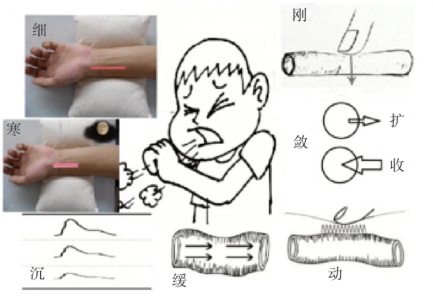
(2) Systematic Differentiation of Pulse Manifestation
In clinical pulse diagnosis, the pulse characteristics of stiff, constricted, and cold can indicate the diagnosis of Cold Evil. Based on the differences in accompanying pulse elements, different syndrome groups can be differentiated.
If the pulse shows characteristics of “thick,” “moving,” “hot” in the blood flow, it indicates Cold Evil binding the exterior, transforming into heat syndrome; if it also shows “cold,” “slow,” “weak,” “deep” pulse elements, it indicates Cold Evil injuring Yang syndrome; if it shows “thin” pulse elements, it indicates Cold Evil invading externally, with phlegm and fluids generated internally syndrome.
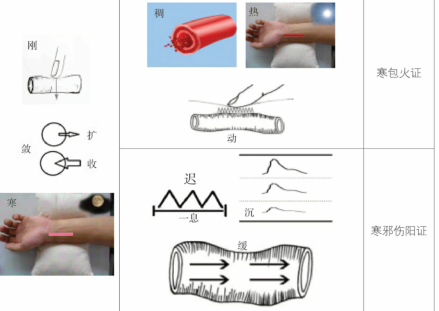
3. Pulse Manifestations of Heat Evil
After the summer solstice and before the beginning of autumn, excessive heat that harms the body is classified as Heat Evil. Heat Evil has a clear seasonality, being a Yang evil, transformed from the hot air of midsummer, characterized by its heat; Heat Evil has the properties of upward and outward movement, easily disturbing the spirit, dispersing the muscles, causing excessive sweating, and harming Qi and fluids; during the hot season, rain and humidity are common, which can easily combine with Damp Evil to cause problems. Heat Evil can be classified into “injured heat” and “heat stroke” based on the onset speed and severity of the condition.
(1) Elements of Pulse Manifestation for Heat Evil
1. Local Pulse Manifestation Elements:
Moving, Hot: Heat fills the body, radiating outward, manifested as a vigorous and active right wrist pulse, with a sensation of heat radiating outward.
Withered: Heat Evil consumes the body’s Yin blood and fluids, leading to a lack of nourishment in the pulse, hence the left wrist pulse appears withered.
2. Overall Pulse Manifestation Elements:
Hot, Rapid, High: Heat fills the body, causing pathological hyperactivity of Yang Qi, resulting in a hot, rapid, and high pulse.
Stiff or Soft: Yin heat and cold evils cause the muscles to contract, increasing the tension in the radial artery walls; if the Damp Evil is severe, the meridians may relax, leading to decreased tension in the radial artery walls.
Thick, Slippery: Heat and Dampness fill the body, increasing the viscosity of the blood, resulting in a thick and slippery pulse.
Vascular walls and surrounding tissue boundaries are “blurred”: The sticky nature of Dampness leads to thickened blood, affecting the normal conduction of vibrations between the vascular walls and surrounding tissues.
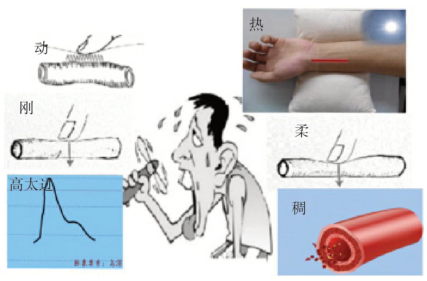
(2) Differentiation of Pulse Manifestation
In clinical pulse diagnosis, the pulse characteristics of stiff, cold, and thick/slippery can indicate the diagnosis of Yin Heat Evil; based on the pulse characteristics of floating, scattered, and hot, the diagnosis of Heat Evil can be made. Based on the differences in accompanying pulse elements, different syndrome groups can be differentiated.
In the characteristics of the pulse indicating Yin Heat Evil, if there is a very obvious characteristic of “stiff” on the right side of the wrist pulse and a “constricted” manifestation, it indicates the diagnosis of Yin Heat directly penetrating the interior; in the characteristics of the pulse indicating Heat Evil, if there are elements of “thick,” “slippery,” and blurred boundaries between the vascular walls and surrounding tissues, it indicates Heat Evil combined with Dampness syndrome; if the right wrist pulse shows “moving,” “high,” and “hot” pulse elements, it indicates Heat Evil syndrome; if the overall pulse shows “rough” and “weak” pulse elements, it indicates Heat Evil consuming Qi syndrome; if the overall pulse shows “thin” and “rough,” with the left wrist pulse being “withered,” it indicates Heat Evil injuring fluids syndrome.
1. Yin Heat:
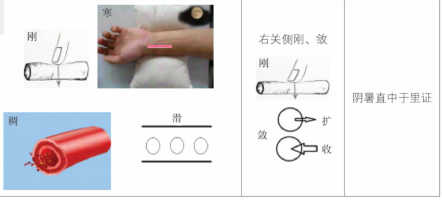
2. Heat Dampness:
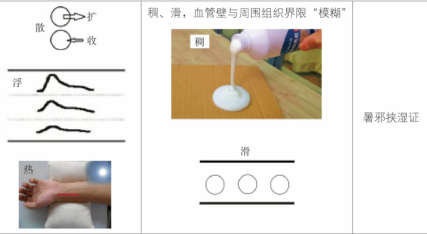
3. Heat Evil:

4. Pulse Manifestations of Damp Evil
Excessive Dampness that harms the body is classified as Damp Evil. Dampness is the main Qi of the long summer, hence Damp Evil is prevalent during this season. Diseases caused by Dampness are termed external Damp diseases, often arising from humid climates, exposure to rain, living in damp environments, or working in water. Dampness is a heavy and turbid evil, being a Yin evil that can damage the body’s Yang Qi, stagnating in the organs and meridians, obstructing the movement of Qi; Dampness is characterized by heaviness and a sense of weight, leading to clinical manifestations primarily characterized by a feeling of heaviness; Dampness is turbid and unclear, presenting with turbid secretions and excretions; Dampness is sticky and stagnant, manifesting as sticky symptoms and a prolonged course of illness; Dampness, being heavy and turbid, tends to affect the lower parts of the body.
(1) Elements of Pulse Manifestation for Damp Evil
1. Local Pulse Manifestation Elements:
Thick, Slippery, Slow: The heavy and turbid nature of Dampness obstructs the middle burner, leading to unfavorable Qi movement, resulting in a thick, slippery, and slow pulse at the right guan position.
Stiff: Damp Evil infiltrates the skin or limbs, causing obstruction in the meridians, leading to increased tension in the corresponding radial artery.
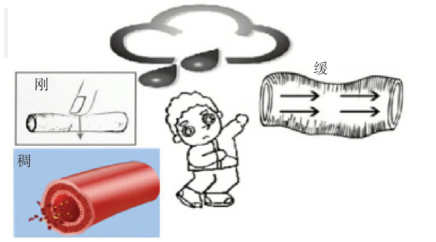
2. Overall Pulse Manifestation Elements:
Deep, Short, Weak Pulsation: Damp Evil obstructs Yang Qi, leading to a deep pulse; when Qi movement is hindered, the pulsation along the vascular wall shortens, and the fluctuation speed of the pulse decreases.
Downward: Dampness tends to move downward, often affecting the lower parts of the body.
Soft: The soft nature of Dampness leads to decreased tension in the radial artery walls.
Rough, Blurred Boundaries: Damp Evil causes an increase in body fluid volume, leading to a full pulse; the retention of Damp Evil in the body causes phlegm and turbid accumulation, affecting the resonance between the pulse and surrounding tissues.
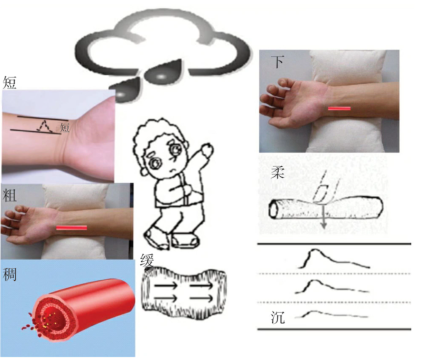
(2) Systematic Differentiation of Pulse Manifestation
In clinical pulse diagnosis, the pulse characteristics of thick, slippery, and short can indicate the diagnosis of Damp Evil. Based on the differences in accompanying pulse elements, different syndrome groups can be differentiated.
If the radial artery shows “stiff” pulse elements, it indicates the invasion of Damp Evil, obstructing the meridians; if it shows “short,” “slow,” and “more coming than going” pulse elements, it indicates the invasion of Damp Evil, obstructing Qi; if it shows “thick,” “slow,” “rough,” and blurred boundaries between the vascular walls and surrounding tissues, it indicates the stagnation of turbid evil; if it shows “thin,” “rough,” “soft,” and “slippery” pulse elements, it indicates the invasion of Damp Evil, with internal water retention; if it shows “hot,” “thick” pulse elements, it indicates the invasion of Damp Evil, with turbid heat transformation; if it shows “thin,” “slow,” “cold” pulse elements, it indicates the invasion of Damp Evil, with water dampness injuring Yang.
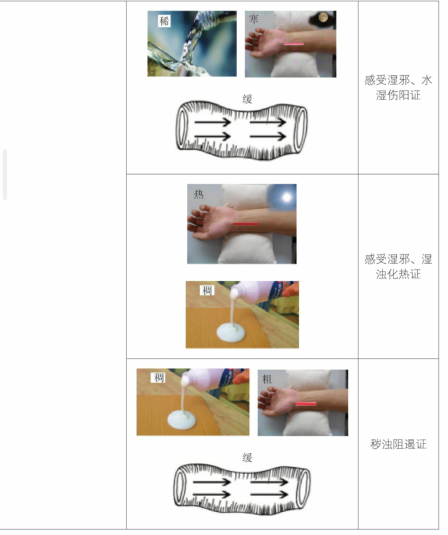
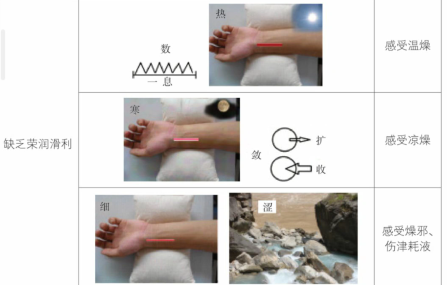
5. Pulse Manifestations of Dry Evil
Dryness is the main Qi of autumn; excessive autumn dryness invading the body is classified as Dry Evil. The nature of Dry Evil is dryness, which can easily harm the body’s fluids, leading to various symptoms of dryness and fluid damage, particularly evident in the lungs, which are the sites of exchange with the external environment, manifesting as dry cough with little phlegm, and blood-streaked phlegm.
(1) Elements of Pulse Manifestation for Dry Evil
1. Local Pulse Manifestation Elements:
Rough, Withered: Dry Evil harms fluids, and the lungs are most susceptible, hence the right cun pulse often appears rough; fluid damage leads to insufficient nourishment of the blood vessels, often seen in the left wrist pulse.
2. Overall Pulse Manifestation Elements:
Fine: Dry Evil harms fluids, leading to insufficient blood volume and unfilled blood vessels.
Rapid, Hot: When experiencing warm dryness, the internal heat is abundant, leading to an increased heart rate.
Constricted, Cold: When experiencing cool dryness, the blood vessels constrict; Yang Qi is injured, leading to poor warming.
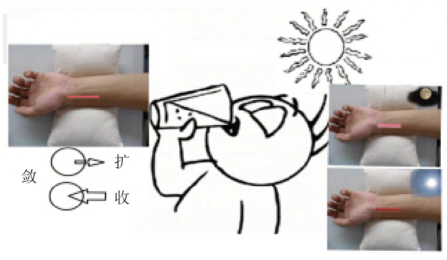
3. Evolution of Pulse Manifestation:
The right wrist pulse is rough and strong: Dry Evil harms fluids, leading to fluid deficiency, causing the large intestine to lose moisture, resulting in dry and hard stools.
(2) Systematic Differentiation of Pulse Manifestation
In clinical pulse diagnosis, the pulse characteristics of “lack of nourishment and lubrication” can indicate the diagnosis of Dry Evil. Based on the differences in accompanying pulse elements, different syndrome groups can be differentiated.
If it also shows “rapid,” “hot” pulse elements, it indicates the diagnosis of warm dryness; if it shows “cold,” “constricted” pulse elements, it indicates the diagnosis of cool dryness; if it shows “fine,” “rough,” and the left wrist pulse being “withered” pulse elements, it indicates the invasion of Dry Evil, harming fluids syndrome.

6. Pulse Manifestations of Fire Evil
Fire heat can occur in all four seasons; whenever external heat is excessive and invades the body, it is classified as Fire Evil. Fire is a Yang evil, leading to excess heat diseases; the nature of fire is to inflame; “strong fire consumes Qi,” leading to the dissipation of Yang Qi; excessive fire forces fluids to leak out, causing damage to Yin fluids; excessive fire and heat can easily provoke wind; Fire Evil can invade the Ying and blood, disturbing the spirit; heat entering the Ying and blood can cause blood to flow erratically; excessive heat can lead to blood stagnation and tissue necrosis.
(1) Elements of Pulse Manifestation for Fire Evil
1. Local Pulse Manifestation Elements:
Hot: When fire heat accumulates in a specific area of the body, the corresponding pulse position feels hot.
Rough: Fire heat fills the body, forcing blood flow, leading to an increase in local blood flow, hence the corresponding pulse position appears rough.
Slippery: Fire heat enters the Ying and blood, boiling the fluids, leading to a slippery pulse in the local area.
2. Overall Pulse Manifestation Elements:
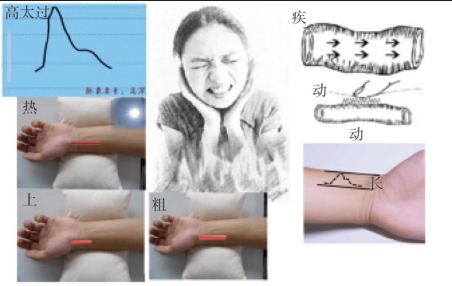
Hot (characteristic pulse manifestation of Fire Evil): Fire heat fills the body, manifested as a vigorous heat sensation in the radial artery.
Moving, High, Rough: The righteous Qi resists the evil outwardly, causing the pulse vessels to become rough, and the rising pulse shows signs of “agitation,” especially at the beginning of the pulse.
Strong, Rapid, High, Long: Fire heat fills the body, leading to an increased heart rate and cardiac output, resulting in faster blood flow, with higher internal pressure in the radial artery and increased pulse conduction distance.
Upward: The fiery nature rises, impacting the head and face, hence the pulse expands towards the distal end of the wrist.
Rapid, Weak, More Coming than Going: The heat in the Qi level is excessive, causing turbulent blood flow, with a rapid pulse at the onset and a slow return, disrupting the normal pulsation.
(2) Systematic Differentiation of Pulse Manifestation
In clinical pulse diagnosis, the pulse characteristics of hot, moving, and strong can indicate the diagnosis of Fire Evil. Based on the differences in accompanying pulse elements, different syndrome groups can be differentiated.
If the pulse shows rough, long, rapid, and strong elements, it indicates the diagnosis of Fire Evil, with heat evil relaxation; if it shows slippery, rapid, and high elements, it indicates Fire Evil, with internal heat accumulation; if it shows slippery, rapid, fine, and high elements, it indicates Fire Evil, with heat entering the Ying and blood; if it shows fine, constricted pulse elements, it indicates Fire Evil, with heat generating wind; if it shows fine, withered pulse elements, it indicates Fire Evil, with heat injuring Yin; if it shows fine, rough pulse elements, it indicates Fire Evil, with heat causing blood stasis; if it shows local protruding, slippery, and thick pulse elements, it indicates Fire Evil, with local heat causing tissue necrosis; if it shows fine, deep pulse elements, it indicates Fire Evil, with heat stagnation.
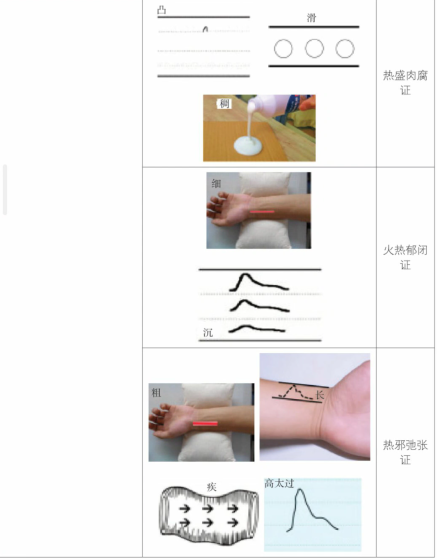


Recommended Reading:
Illustrated Explanation of the String Pulse
Why do I always feel that there is no difference in pulse manifestations?
I Copyright Statement
-
Authors/Teng Jing, Qi Xianghua, Editor/Yuan Tao.
-
This article is excerpted from “Introduction to Systematic Pulse Diagnosis Illustrated,” copyright belongs to the relevant rights holders. Sharing this article is for the purpose of dissemination and learning exchange. If there are any improper uses, please feel free to contact us.
I Contact email: [email protected]
